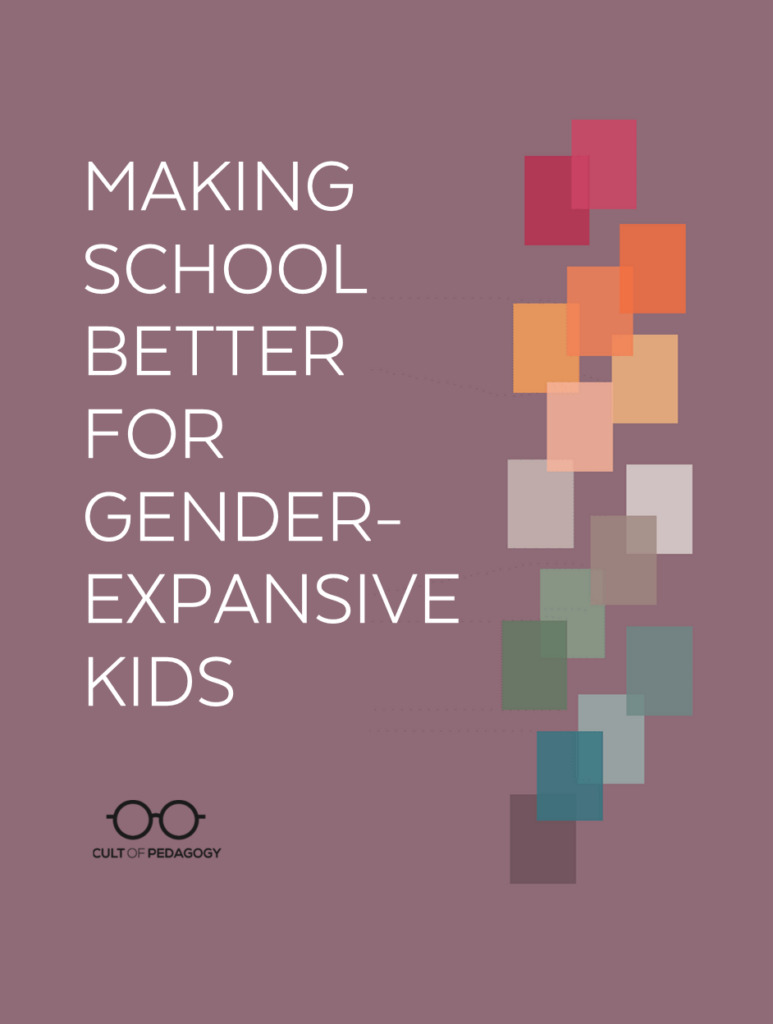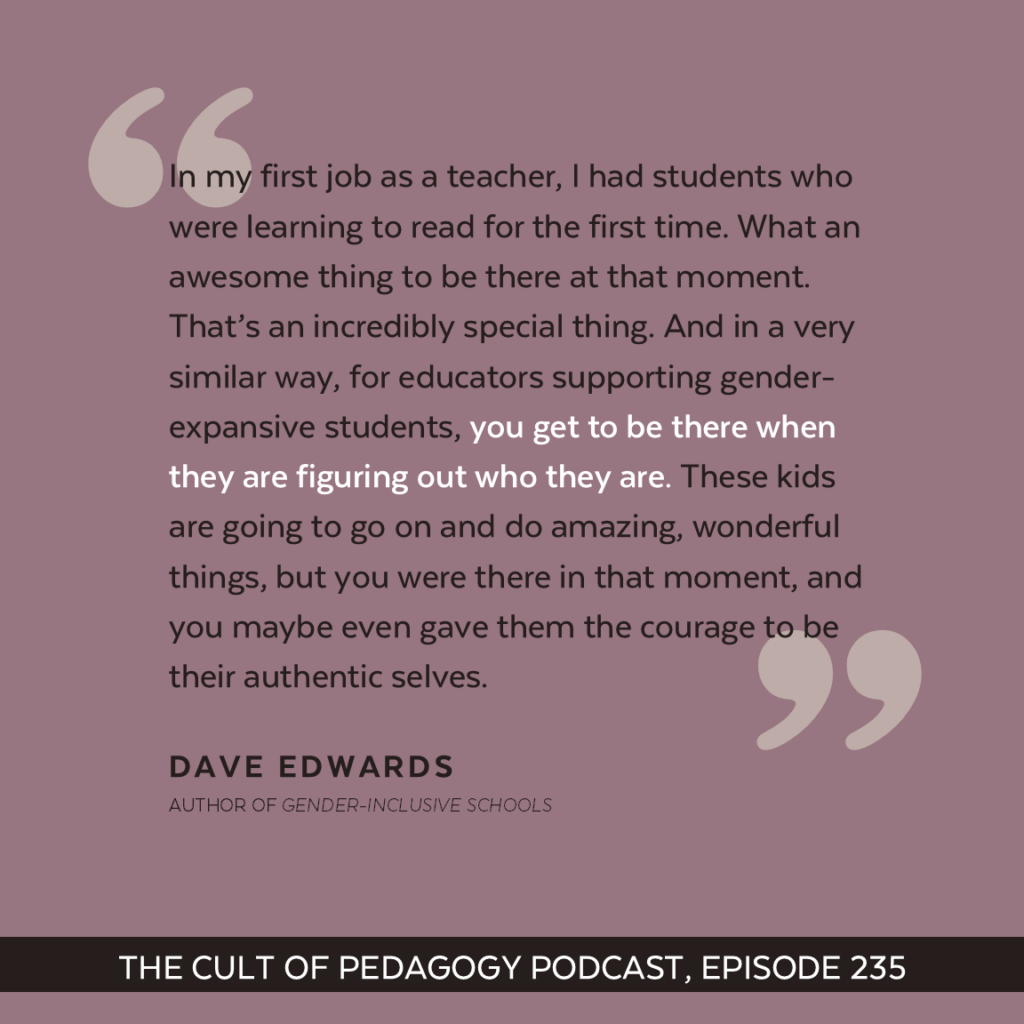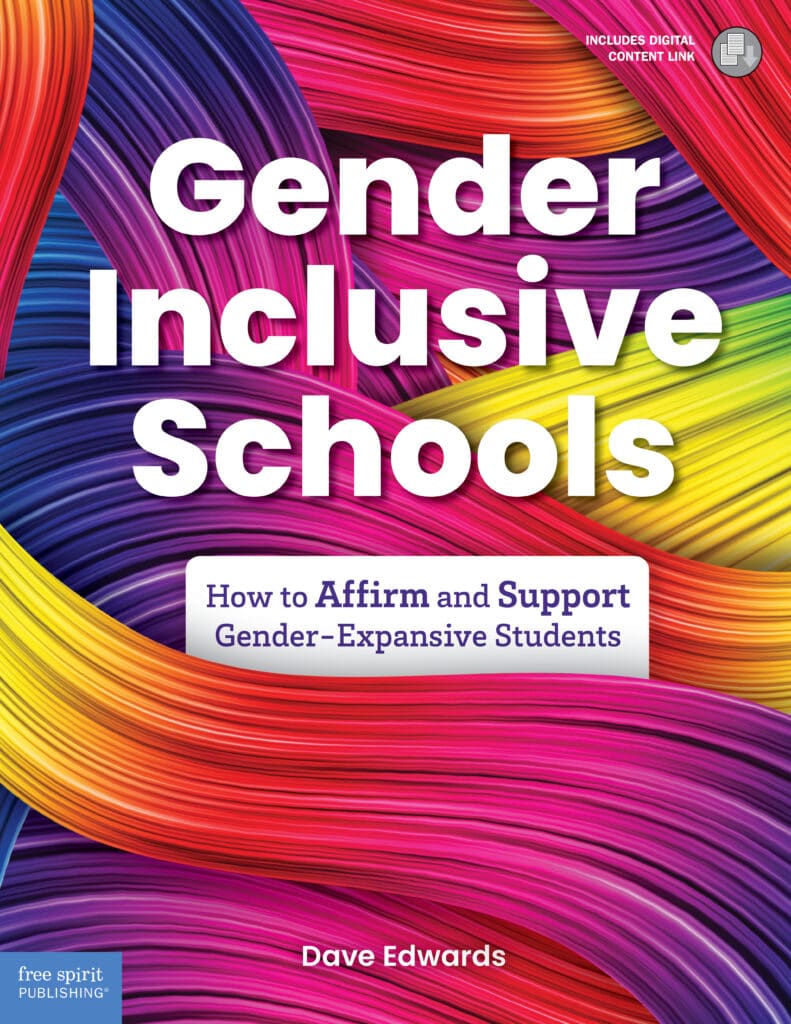
Listen to my interview with Dave Edwards (transcript):
Sponsored by Listenwise and The Wired Classroom
This page contains Amazon Affiliate and Bookshop.org links. When you make a purchase through these links, Cult of Pedagogy gets a small percentage of the sale at no extra cost to you. What’s the difference between Amazon and Bookshop.org?
According to recent studies, the number of people who identify as nonbinary or transgender has risen steadily over the last 10 years or so. Your opinion on this is likely to fall into one of several camps: Maybe you see this as a reflection of society’s growing acceptance of gender fluidity. Maybe you see it as a bandwagon young people are jumping on just to be like their peers. Maybe you believe gender fluidity has always been a part of human existence and that those statistics only exist because we are just now getting around to naming and measuring it. Maybe you’re not sure what to make of it.
Regardless of where your understanding of gender fluidity lies, what you probably have in common with your fellow educators is that you want all of your students to feel safe, accepted, and loved while they are under your care. You know that if this doesn’t happen, they won’t be able to learn and grow. And for gender-expansive students — whose gender expression or identity is different from what they were assigned at birth — creating that safety and acceptance isn’t just a simple matter of being nice to them. There are some very specific do’s and don’ts that, once we learn them, can make a huge difference in how these kids experience school.
The good news is that some schools are already on their way to supporting these kids. A 2024 Trevor Project survey found that 54 percent of transgender and nonbinary young people found their school to be gender-affirming, and those who did reported lower rates of attempting suicide. Unfortunately, that means 46 percent do not feel affirmed in their schools, so there’s clearly room for improvement.
On the podcast, we review some of those do’s and don’ts. My guest is Dave Edwards, an educator who works to teach these principles through his brand-new book, Gender-Inclusive Schools (Amazon | Bookshop.org), and his website of the of the same name. As the parent of a transgender daughter who has experienced discrimination, Dave’s mission is a personal one. Through his trainings, his resources, and now his book, he helps educators learn how to proactively create safe learning environments for LGBTQ+ young people. In our conversation, we covered topics like names and pronouns, social transitioning, sports and activities, and access to facilities — like bathrooms — to name just a few.

One of my biggest takeaways from reading Dave’s book is that even those of us who consider ourselves to be strong supporters of gender-expansive kids can cause harm by doing things with the best of intentions. So I encourage everyone to listen — whether you’re uncertain and even uncomfortable about this topic, or you think you already have a good handle on how to be supportive. There’s still plenty to learn.
Below are a few highlights from our conversation.
Guiding Principles for Supporting Gender-Expansive Students
In the book, Edwards frames all of his recommendations around two guiding principles: (1) Support healthy and happy kids, and (2) Protect privacy and confidentiality.
Principle 1: Support Healthy and Happy Kids
Edwards set this as the first principle as a way to reframe the way some schools tend to approach their support for gender-expansive kids, which is too often done through a lens of compliance, rather than care.
“There is so much legal kind of nonsense going around,” he explains, “different laws being passed that are guiding their access to things like facilities or using their name and pronouns. And I think when school communities only focus on their legal responsibilities, everybody loses. As the parent of a trans kid, I don’t want my child’s teachers to support her because it’s required by law. I want them to support her because they care about her and she’s an important person that’s a member of the school community. So that ‘Support happy and healthy kids’ guideline, you know, that really comes from each chapter, looking at the different content and saying, How is this related to positive outcomes? If it’s not, we shouldn’t be doing it, and if we are, it needs to be the best thing possible because we really care about these kids.”
Principle 2: Protect Privacy and Confidentiality
“All information related to a student’s sexual orientation and gender identity should be treated like private medical data,” Edwards says. While this seems simple enough, thinking through how it plays out in specific scenarios illustrates why it’s a guiding principle that blankets all areas. “When a student changes their name and pronouns,” he offers, “who should be informed? Who has a right to that information? When they’re accessing facilities, is that something that can just be shared without their permission or do students have agency over controlling information that describes who they are?”
What may surprise you (as it did me) is that many breaches of confidentiality come from teachers with the best of intentions. Edwards explains: “So they say, Oh, you’ve told me this information about who you are. I’m going to tell my colleagues so that they can be kind and respectful too. When the reality is you need to be constantly checking and allowing students to have agency over that information and saying things like, I was thinking I could talk to this teacher, and then they would know your pronouns already. Or whatever it might be. But giving students the opportunity to say, Yeah, that’s a great idea, or No, that’s okay. I would rather handle that myself. Once someone has that information when they weren’t supposed to, you can’t really put it back. So that’s why it’s so important to be proactive.”
Responding to Challenging Questions and Comments
One of the book’s most important features is the advice in every chapter on responding to challenging questions and comments. These are typical scenarios educators are likely to encounter in their school community, along with suggested responses.
Edwards added this piece based on his own experience working with educators. “Schools will call me and say, this parent just called, and they said this thing. What should I have said? Or I got flustered and I wasn’t sure what to say, so now I said this thing. One thing we keep coming back to in the book is that school communities are safest when they’re predictable and where all the adults say the exact same things. So if someone expresses a comment that has some bias or some discrimination in it, how do we know that all the adults in the building are going to respond in exactly the same way? Because when they don’t, then a parent or caregiver may ask like four different staff members until they get the response that they want. Or someone might say something on accident that doesn’t reflect the values of the school community or what your policies are. So it’s incredibly important for educators to think about and practice before a situation occurs so they can really say what they mean, mean what they say, and most importantly protect those gender-expansive kids.”
Some examples of these suggested responses are included below.
More Specific Ways to Support Gender-Expansive Students
Using the above principles as a guide, Edwards walks the reader through the most common school-specific contexts and situations where transgender and gender-diverse students are likely to receive different or even discriminatory treatment, and offers guidance for educators on the best ways to be supportive.
Names and Pronouns
“I think educational best practice is to use the language that people ask you to use to describe who they are,” Edwards says. “And this applies to gender-expansive, transgender, and nonbinary students too. So what I recommend for schools is that their policies just say, Here at our school we use the name and pronouns our students ask us to use, no questions. By lowering the temperature on names and pronouns, we get (this issue) out of the way so our students can focus on learning. We don’t want to be spending all of our time trying to navigate concerns like this.”
Using a student’s chosen name and pronouns can also have other challenges. For one thing, there needs to be a way for students to inform their teachers about their preferences — the book provides a reproducible form for this purpose. Once that information is known, the adults in the building may struggle to get the names and pronouns right. Edwards has found that the best path to success in this area is practice.
“When a student changes their name or pronoun and you might have known that student for three, four years, mistakes are going to happen in that moment of transition. We say for educators, it’s a reasonable expectation for you to get better at a student’s name and pronouns over the course of the school year.”
The book offers another printable tool to help with that process: a story practice form. “You’re able to list the student’s new name and then all the different versions of their pronouns, and then there’s a social story where you plug those in so you can begin practicing in conversation to fluently using a student’s pronouns, especially if you’re new to maybe using singular ‘they’ or nonbinary pronouns. This is a great opportunity to practice away from a student. We want to do that practicing kind of outside of a position where it might cause harm so that when we are interacting with that person in the classroom, we reduce the number of mistakes that we’re making.” When teachers model this kind of practice, Edwards says, they set a wonderful example of lifelong learning for students.
Social Transitions
“When we use the term social transition in a school context,” Edwards explains, “we’re talking about the steps someone may or may not take to bring their outward expression of their gender and their identity into congruence with who they are and know themselves to be. So for students, this looks like maybe changing names and pronouns, maybe not. It looks like changing your gender expression, so the way you might express your gender through things like hair or clothing or your mannerisms. It may mean accessing different facilities, so going in a different binary restroom if those are the choice available. Or participating in clubs and different sports, things like that, in a way that matches your gender identity. So all of those steps are kind of in that social transition process.”
How can faculty and staff support kids when they transition socially? Number one on Edwards’ list is “following a student’s lead and their parents and caregivers if they’re involved in the process too. We shouldn’t take any steps to support gender-expansive kids at school unless we’ve checked to make sure that’s what that student wants. So if someone uses a new name and pronoun, how are you going to tell students? How are you going to tell — or are you going to tell different educators in the building? What’s the best way that communicates that information that also honors the student’s wishes?”
The answer to this will vary with every student. “There are some kids who will just want a simple announcement,” he says, “something like This is _____. This is their name, these are their pronouns.” Other students may want a lot more. “I’ve worked with students who want to do a PowerPoint — they want to tell their story and show baby pictures and talk about what gender means as a social construct, just really educate all of their friends and peers. And if that’s what your students would like, then great. But in no way should a student be required to educate the people in their school community in order to be safe.”
Navigating these decisions can be tricky. Sometimes, well-meaning teachers make the mistake of sharing information about a student’s social transition before that student is ready to have it shared. Although the intention is to bring others on board to support the student, disclosing this information without the student’s permission is a big privacy violation. In the book, Edwards cautions staff members to never “accelerate, delay, encourage, or discourage a student in sharing information about their gender” (34).
It can take some time for the student to get used to the necessary trade-off that comes with social transition. “There’s kind of this realization for gender-expansive kids that occasionally you do give up a little bit of your privacy in order to be treated correctly,” Edwards explains. “I worked with a kindergarten nonbinary student who used they/them pronouns, and they were walking through the halls every day of school, and they kept getting misgendered by random adults, other teachers, or other students in the lunch line. But they didn’t want to tell anyone that their pronouns were they and them. So there was this moment of like, oh well, you kind of have to tell people in order for them to treat you correctly. Which seems like common sense to us, but I think it’s also like a really great life skill for students to start kind of navigating. Like, oh, I need to take control a little bit. I do have to communicate or talk to other people to make sure that I get what I need.”
One way to help social transitions go smoothly is to hold what Edwards calls a gender support meeting. “When I work with parents of gender-expansive kids it can be really helpful for them to sit down with a couple people at school, some trusted adults that work with their student to walk through those different items, like which facility is the student going to access? How are you going to tell a student’s peers? Are you going to tell these people over here?”
Medical Transitions
Despite claims by some that schools are enabling, or in some cases, even performing gender reassignment surgeries during the school day, “medical transitions are completely outside of a school district’s responsibility or an educator’s responsibility,” Edwards says. “(They) aren’t the business of school staff in any way at all. There’s so much misinformation that’s meant to kind of whip up hysteria about the care that’s provided to trans kids or gender-expansive kids. Almost always, school staff have no role to play in a student’s medical transition, beyond just being affirming and supportive the same way you would with any other student’s medical needs or concerns.”
If educators are challenged by community members on this topic, Edwards advises responses like, “Decisions related to the gender-affirming care of our students are made privately between the students and their families and medical teams.” In cases when a more general statement or challenge comes up, an effective response is to ask, “Is this a hypothetical situation or is there an actual event or circumstance you would like to discuss?”
Facilities Access
When it comes to spaces like restrooms and locker rooms, Edwards says “Every major medical and psychological association would recommend that trans kids and gender-expansive kids access the facilities that match their gender identity.” Despite those recommendations, he says, “many states have laws specifically prohibiting best practice. It’s kind of a cultural moment where educators know what’s best for kids but then they’re sometimes prohibited from following those recommendations by either their school district policies or by state law. If we think that’s confusing as adults, it’s also really confusing for kids too, to be messaged like values of inclusion and respect as being universal, but then navigating circumstances that make that impossible. So if that’s possible, making sure that students have access to the facilities that match their gender identity.”
Along those same lines, all students should have more options for increased privacy. “It shouldn’t be a condition of enrollment that you need to show your body to someone else to benefit from the free and appropriate public education. There are wonderful single stall restroom designs that cost about the same as regular, traditional binary restrooms. It’s really just a matter of doing that work and making that a possibility for your school community. a lot of them will have like a bank of those kind of floor to ceiling stalls, and then a common area to wash hands.” It’s not just gender-expansive kids who benefit from increased privacy options — they’re useful for students with disabilities and others as well.

Other Situations
In our interview, we also talked about gender-affirming policies around participation in sports and some of the tools included in the book to help schools assess where they are in terms of gender-inclusive practices.
Appreciating the Privilege and Joy of this Moment
Amid all the details and advice that come along with supporting these students, Edwards makes it a priority to remind us of how important this time of life is for our students, how joyful it can be, and how privileged we are to witness and be a part of it.
“My first job as a teacher was as a special education teacher in Chicago Public Schools, and I had third and fourth graders who were learning to read for the first time,” he says. “What an awesome thing to be there at that moment where that child couldn’t do this before and then we worked really hard together, sometimes in groups, sometimes individually, but now they could do this thing and whatever they do in their life, I was there when you first learned how to read. That’s an incredibly special thing. And in a very similar way, for our educators who are supporting gender-expansive students, it’s like, you get to be there when they are figuring out who they are. These kids are going to go on and do amazing, wonderful things, but you were there in that moment, and you can know that you were unbelievably supportive and affirming and it maybe, maybe even gave them the courage to be their authentic self.”
Join our mailing list and get weekly tips, tools, and inspiration that will make your teaching more effective and fun. You’ll get access to our members-only library of free downloads, including 20 Ways to Cut Your Grading Time in Half, the e-booklet that has helped thousands of teachers save time on grading. Over 50,000 teachers have already joined—come on in.







What about the girls who do not want to share bathrooms with males? Have you thought about the other population youre supposed to protect and serve? This message is dangerous and doesn’t misogynistic; it teaches our girls that they don’t have a right to privacy and respect. Big oof and unfollow.
Thank you for taking the time to share your concerns. I invite you to listen to Jenn’s conversation with Dave Edwards on the podcast, where he specifically talks about this topic. I think you’ll find that what he recommends is that all students have options for increased privacy and that they all be treated with kindness and respect, so that they can focus on learning. Jenn’s goal, as it has always been, is to share resources with teachers that enable them to create the best conditions for learning in every classroom.
Dave Edward’s language around the JOY of witnessing and celebrating identity was so beautiful! It caught me off-guard, as it’s rarely something we talk about. It IS a privilege to help each child be their most authentic self, and I look forward to making some tweaks in my school’s systems. Thank you for this episode, it is by far and away one of my favorites (and I am a long-time follower).
LL, thank you so much. This means a lot to me. I was also taken aback in the best way by Edwards’ emphasis on joy. We need so much more of this in so many places. I’m honored to know that this episode has risen up in the ranks for you. XO